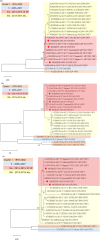Complete sequence analysis of human norovirus GII.17 detected in South Korea
- PMID: 31364537
- PMCID: PMC6624861
- DOI: 10.1017/S0950268819000943
Complete sequence analysis of human norovirus GII.17 detected in South Korea
Abstract
Norovirus, a major cause of gastroenteritis in people of all ages worldwide, was first reported in South Korea in 1999. The most common causal agents of pediatric acute gastroenteritis are norovirus and rotavirus. While vaccination has reduced the pediatric rotavirus infection rate, norovirus vaccines have not been developed. Therefore, prediction and prevention of norovirus are very important. Norovirus is divided into genogroups GI-GVII, with GII.4 being the most prevalent. However, in 2012-2013, GII.17 showed a higher incidence than GII.4 and a novel variant, GII.P17-GII.17, appeared. In this study, 204 stool samples collected in 2013-2014 were screened by reverse transcriptase-polymerase chain reaction; 11 GI (5.39%) and 45 GII (22.06%) noroviruses were identified. GI.4, GI.5, GII.4, GII.6 and GII.17 were detected. The whole genomes of the three norovirus GII.17 were sequenced. The whole genome of GII.17 consists of three open reading frames of 5109, 1623 and 780 bp. Compared with 20 GII.17 strains isolated in other countries, we observed numerous changes in the protruding P2 domain of VP1 in the Korean GII.17 viruses. Our study provided genome information that might aid in epidemic prevention, epidemiology studies and vaccine development.
Keywords: GII.17.; Gastroenteritis; norovirus; phylogenetic tree; sequence analysis.
Conflict of interest statement
None.
Figures




Similar articles
-
Clinical and epidemiological characteristics of norovirus gastroenteritis among hospitalized children in Lebanon.World J Gastroenterol. 2016 Dec 28;22(48):10557-10565. doi: 10.3748/wjg.v22.i48.10557. World J Gastroenterol. 2016. PMID: 28082807 Free PMC article.
-
Evolutionary phylodynamics of Korean noroviruses reveals a novel GII.2/GII.10 recombination event.PLoS One. 2014 Dec 12;9(12):e113966. doi: 10.1371/journal.pone.0113966. eCollection 2014. PLoS One. 2014. PMID: 25500567 Free PMC article.
-
Genetic diversity of noroviruses in Taiwan between November 2004 and March 2005.Arch Virol. 2006 Jul;151(7):1319-27. doi: 10.1007/s00705-005-0717-4. Epub 2006 Feb 7. Arch Virol. 2006. PMID: 16463123
-
Molecular epidemiology and genotype distributions of noroviruses and sapoviruses in Thailand 2000-2016: A review.J Med Virol. 2018 Apr;90(4):617-624. doi: 10.1002/jmv.25019. Epub 2018 Jan 23. J Med Virol. 2018. PMID: 29315631 Review.
-
Molecular epidemiology of norovirus in South Korea.BMB Rep. 2015 Feb;48(2):61-7. doi: 10.5483/bmbrep.2015.48.2.254. BMB Rep. 2015. PMID: 25441425 Free PMC article. Review.
Cited by
-
Viral metagenomics reveals diverse viruses in the fecal samples of children with diarrhea.Virol Sin. 2022 Feb;37(1):82-93. doi: 10.1016/j.virs.2022.01.012. Epub 2022 Jan 17. Virol Sin. 2022. PMID: 35234620 Free PMC article.
-
Genome characterisation of norovirus GII.P17-GII.17 detected during a large gastroenteritis outbreak in Romania in 2021.Arch Virol. 2023 Mar 22;168(4):116. doi: 10.1007/s00705-023-05741-6. Arch Virol. 2023. PMID: 36947248
References
-
- Cho HG et al. (2015) Emergence of norovirus GII.4 variants in acute gastroenteritis outbreaks in South Korea between 2006 and 2013. Journal of Clinical Virology : the Official Publication of the Pan American Society for Clinical Virology 72, 11–15. - PubMed
-
- Pothier P and Kaiser L (2014) Norovirus disease today. Clinical Microbiology and Infection : the Official Publication of the European Society of Clinical Microbiology and Infectious Diseases 20, 716. - PubMed
Publication types
MeSH terms
LinkOut - more resources
Full Text Sources
Medical

